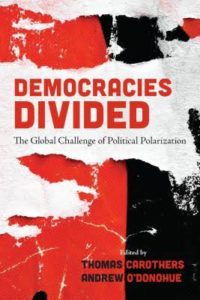By Thomas Carothers and Andrew O’Donohue*
Severe political polarization is tearing at the seams of democracies around the world, from Brazil, India, and Kenya to Poland, Turkey, and the United States. Deep divisions are corroding basic political institutions, fueling societal anger and violence, and ultimately endangering democracy itself.
What can be done to heal political divisions and defend democracy in intensely polarized countries? What efforts have been undertaken to address this problem, and what works?
In our new book Democracies Divided: The Global Challenge of Political Polarization, we address these questions by analyzing nine countries grappling with the problem. Each case study identifies and evaluates the actions that concerned citizens and organizations are taking to counter polarizing forces, and from these cases we extract cross-cutting findings.
Our research underscores that once a society has become deeply divided, it is very difficult to heal. Polarization tends to entrench itself and become self-perpetuating: Polarizing actions and reactions feed on each other, dragging countries into a downward spiral of anger and division. What is more, political leaders frequently have a vested interest in aggravating polarization for their own electoral gain.
 Yet our study also shows that a wide range of actors have tried inventive ways of addressing the problem—and sometimes achieved encouraging results. We identify at least seven types of efforts undertaken to counter polarization, which together form an emerging menu of remedial actions:
Yet our study also shows that a wide range of actors have tried inventive ways of addressing the problem—and sometimes achieved encouraging results. We identify at least seven types of efforts undertaken to counter polarization, which together form an emerging menu of remedial actions:
- In the formal political domain, institutional reforms to limit polarization have focused on decentralizing political power and changing electoral rules, while political party reforms have sought to promote moderate platforms or renovate party leadership.
- In the domain of broader political action, political leaders have endeavored to step back from polarizing narratives, create new opposition parties or coalitions, or even form governments of national unity.
- Outside the strictly political realm, various civic actors have launched dialogue and bridging efforts to foster communication and understanding across partisan divides.
- Media reforms have included initiatives to combat disinformation, prevent the amplification of extremist voices, and establish new media platforms.
- And universities and non-governmental organizations have begun research and study efforts to develop local knowledge about the problem and potential solutions.
- International action can also play a significant role in mediating political conflicts and interrupting a downward spiral of polarization and democratic erosion.
In each of these domains, democracy practitioners can draw valuable insights from previous attempts to limit polarization. And it is worth highlighting that some initiatives in particular have had significant results.
- In the realm of institutional reform, Kenya has sought to ease ferocious competition for national office by decentralizing political power. After decades of criticism by the opposition that the president wielded too much power, the country adopted a new constitution in 2010 that gave regional officials greater autonomy and control over state resources.
- As for broader political action, the leadership of elected officials can play a crucial role in de-escalating partisan divides. In Ecuador, President Lenín Moreno has rejected the polarizing tactics of his predecessor, even though the two come from the same political party. And in Turkey, opposition parties have achieved modest success by uniting to form a coalition: their candidate for mayor of Istanbul won a resounding victory in 2019 with a campaign that emphasized overcoming divisions.
- Finally, a vigorously independent judiciary—as well as robust, impartial election administration—is a crucial bulwark protecting democracies against the ravages of polarization. In India, the Supreme Court has even taken a proactive stand against majoritarianism and the politics of polarization. It has spoken out in defense of democratic institutions and demanded greater accountability for hate crimes and political violence.
Of course, all of these efforts to counter polarization have their own shortcomings, from which practitioners can and should learn. In Kenya, the effect of formal institutional changes has been blunted in practice, because informal networks of corruption have continued to centralize power in the hands of federal officials.
In Ecuador, recent protests against President Moreno have shown that the path from populism to moderation is a difficult one—and that democracy practitioners need to act quickly and flexibly to shore up the gains of a democratic opening before the going inevitably gets tougher.
And while India’s judiciary is an important guardrail limiting polarization and its antidemocratic consequences, building such robust legal institutions is a decades-long process.
Perhaps most importantly, our research underscores that existing initiatives are small compared to the larger forces driving polarization globally. Democracy practitioners will need to rise to this challenge in new and determined ways if they are to help democracies resist the swelling global current of polarization.
*Thomas Carothers is senior vice president for studies at the Carnegie Endowment for International Peace. Andrew O’Donohue is a research fellow at the Istanbul Policy Center. This article draws from their new book, Democracies Divided: The Global Challenge of Political Polarization.







